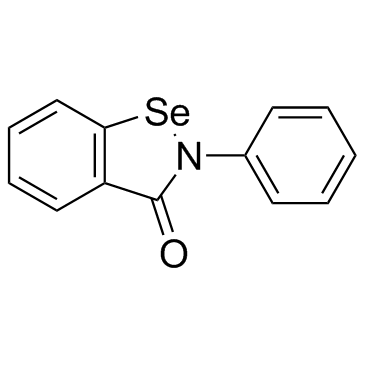Ebselen

Ebselen structure
|
Common Name | Ebselen | ||
|---|---|---|---|---|
| CAS Number | 60940-34-3 | Molecular Weight | 274.177 | |
| Density | N/A | Boiling Point | 402.8±28.0 °C at 760 mmHg | |
| Molecular Formula | C13H9NOSe | Melting Point | 178-181 °C | |
| MSDS | Chinese USA | Flash Point | 197.4±24.0 °C | |
| Symbol |



GHS06, GHS08, GHS09 |
Signal Word | Danger | |
Use of EbselenEbselen is a small-molecule capsid Inhibitor of HIV-1 replication.Target:Ebselen is an organoselenium compound, as an inhibitor of HIV-1 capsid CTD dimerization. Ebselen inhibits early viral postentry events of the HIV-1 life cycle by impairing the incoming capsid uncoating process. [1] Ebselen is a non-toxic seleno-organic drug with anti-inflammatory and antioxidant properties. Ebselen is an inhibitor of inositol monophosphatase (IMPase). Ebselen permeates the blood-brain barrier and inhibits endogenous inositol monophosphatase in mouse brain. [2] |
| Name | ebselen |
|---|---|
| Synonym | More Synonyms |
| Description | Ebselen is a small-molecule capsid Inhibitor of HIV-1 replication.Target:Ebselen is an organoselenium compound, as an inhibitor of HIV-1 capsid CTD dimerization. Ebselen inhibits early viral postentry events of the HIV-1 life cycle by impairing the incoming capsid uncoating process. [1] Ebselen is a non-toxic seleno-organic drug with anti-inflammatory and antioxidant properties. Ebselen is an inhibitor of inositol monophosphatase (IMPase). Ebselen permeates the blood-brain barrier and inhibits endogenous inositol monophosphatase in mouse brain. [2] |
|---|---|
| Related Catalog | |
| References |
| Boiling Point | 402.8±28.0 °C at 760 mmHg |
|---|---|
| Melting Point | 178-181 °C |
| Molecular Formula | C13H9NOSe |
| Molecular Weight | 274.177 |
| Flash Point | 197.4±24.0 °C |
| Exact Mass | 274.984924 |
| PSA | 22.00000 |
| LogP | 2.04770 |
| Vapour Pressure | 0.0±0.9 mmHg at 25°C |
| Storage condition | 2-8°C |
CHEMICAL IDENTIFICATION
HEALTH HAZARD DATAACUTE TOXICITY DATA
|
| Symbol |



GHS06, GHS08, GHS09 |
|---|---|
| Signal Word | Danger |
| Hazard Statements | H301-H331-H373-H410 |
| Precautionary Statements | P261-P273-P301 + P310-P311-P501 |
| Hazard Codes | T:Toxic;N:Dangerousfortheenvironment; |
| Risk Phrases | R23/25;R33;R50/53 |
| Safety Phrases | S20/21-S28-S45-S60-S61-S28A |
| RIDADR | UN 3283 6.1/PG 3 |
| WGK Germany | 3 |
| RTECS | DE4140750 |
| HS Code | 2927000090 |
| HS Code | 2927000090 |
|---|---|
| Summary | 2927000090 other diazo-, azo- or azoxy-compounds。Supervision conditions:None。VAT:17.0%。Tax rebate rate:9.0%。MFN tariff:6.5%。General tariff:30.0% |
|
Role of reactive oxygen species in transforming growth factor beta1-induced alpha smooth-muscle actin and collagen production in nasal polyp-derived fibroblasts.
Int. Arch. Allergy Immunol. 159(3) , 278-86, (2012) Myofibroblasts are detected in nasal polyps and are involved in nasal polyp formation by inducing extracellular matrix accumulation. Reactive oxygen species (ROS) are released during the differentiati... |
|
|
T cell lipid peroxidation induces ferroptosis and prevents immunity to infection.
J. Exp. Med. 212(4) , 555-68, (2015) The selenoenzyme glutathione peroxidase 4 (Gpx4) is a major scavenger of phospholipid hydroperoxides. Although Gpx4 represents a key component of the reactive oxygen species-scavenging network, its re... |
|
|
Reactive oxygen species are involved in BMP-induced dendritic growth in cultured rat sympathetic neurons.
Mol. Cell. Neurosci. 67 , 116-25, (2015) Previous studies have shown that bone morphogenetic proteins (BMPs) promote dendritic growth in sympathetic neurons; however, the downstream signaling molecules that mediate the dendrite promoting act... |
| 2-Phenyl-1,2-benzoselenazol-3(2H)-one |
| 1,2-Benzisoselenazol-3(2H)-one, 2-phenyl- |
| Ebselenum |
| 2-phenyl-1,2-benzoselenazol-3-one |
| Harmokisane |
| Ebselen |
| MFCD00210937 |
| Ebseleno |
| Ebselene |

